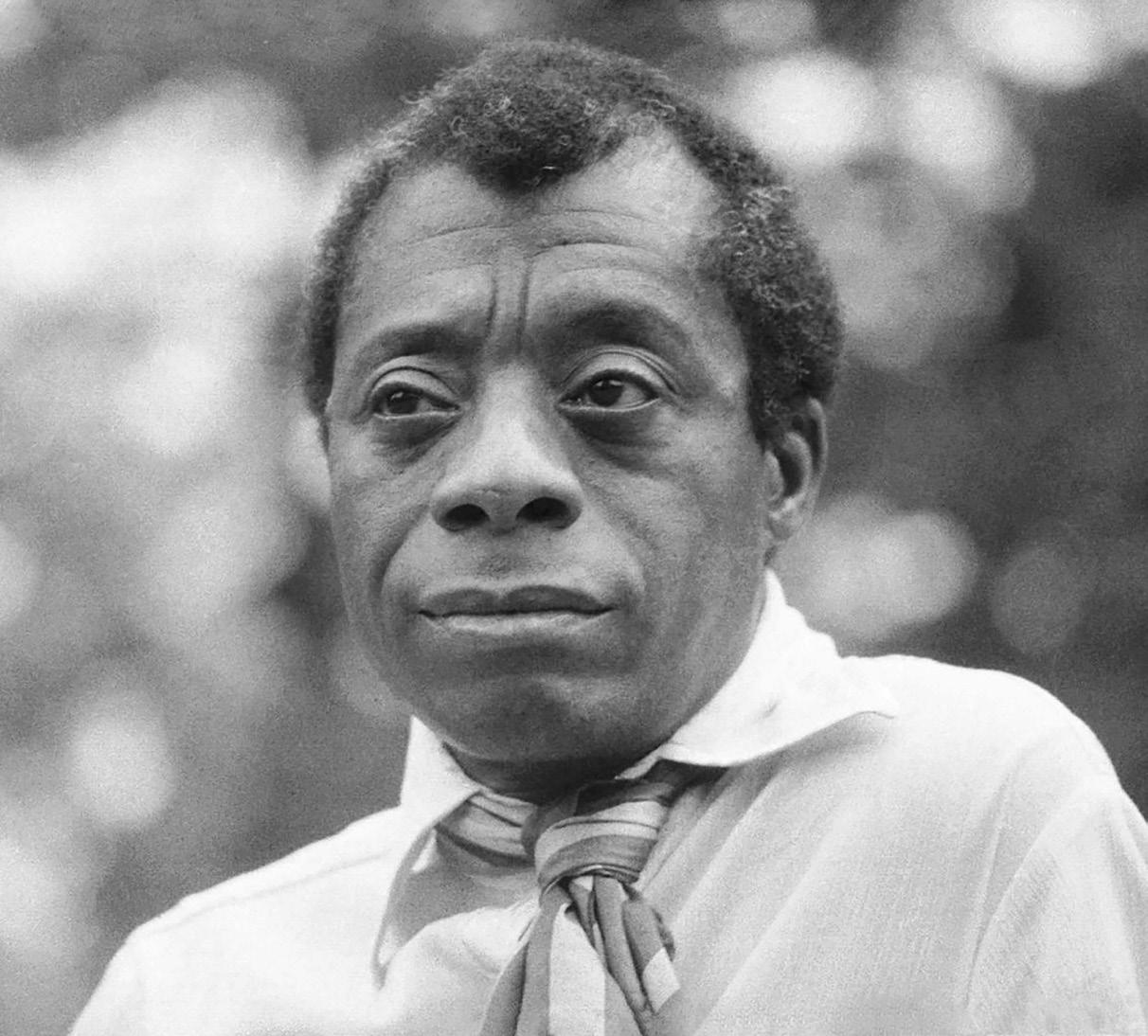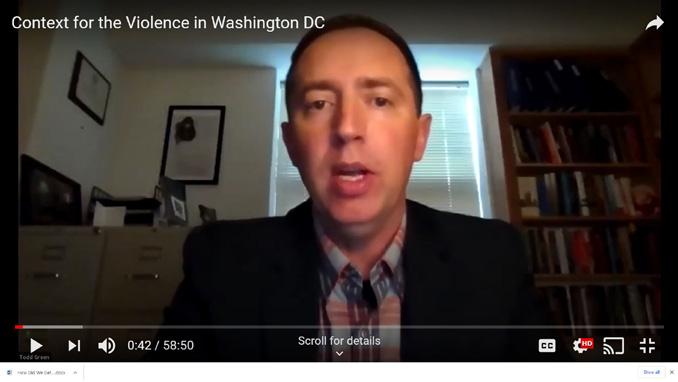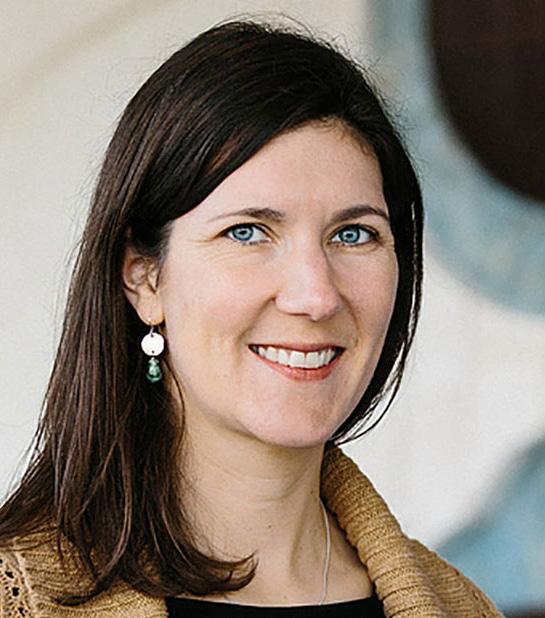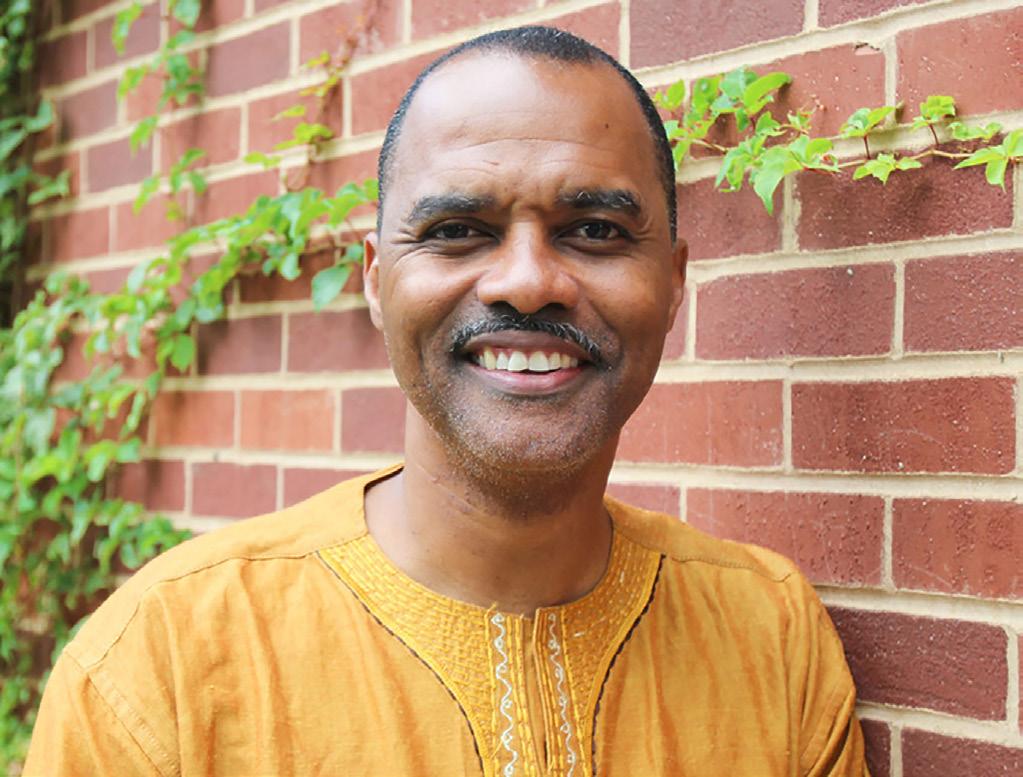
23 minute read
The Love and Rage of James Baldwin, The Unwavering Witness Novian Whitsitt
from Agora Spring 2021
The Love and Rage of James Baldwin, The Unwavering Witness
by NOVIAN WHITSITT, Professor of English and Identity Studies
Editor’s note: This lecture was part of “Luther College Commemorates Black History Month,” a series of live, virtual presentations offered in February to illuminate current events with historical perspectives. Following the lecture, Professor Amy Weldon joined Professor Whitsitt in a discussion of James Baldwin’s short story, “Sonny’s Blues,” on February 15, 2021.
On May 24, 1963, Robert Kennedy, the U.S. attorney general in the John F. Kennedy administration, called for a meeting with James Baldwin and a number of Black leaders, and the meeting took place at Kennedy’s apartment in New York. In addition to Baldwin, there was Kenneth Clarke, the noted research psychologist and educator whose work buttressed the case of Brown vs. the Board of Education in 1954, Lorraine Hansberry, playwright of A Raisin in the Sun, actors Harry Belafonte and Lena Horne, Clarence Jones, one of King’s attorneys, and Jerome Smith, a young Black activist of CORE (Congress of Racial Equality), who had been badly beaten multiple times protesting in the South. The leaders were there with the expressed intention of prodding the Kennedy administration to take a more public stance of support for the civil rights campaign in the South. At the time, protests to desegregate Birmingham were in full swing, and the American public was watching Bull Connor, the Commissioner of Public Safety, give police the authority to use fire hoses and dogs on Black protestors of all ages. By all accounts, the meeting did not go well. Young Jerome Smith quickly grew impatient with Kennedy’s perceived insensitivity and uttered that his being there to ask for rights that he should already possess made him feel like vomiting. He went on to say that if he was ever called to fight in defense of America, he would never do it, to which Kennedy accused him of lacking patriotism. That was the tipping point. All of the Black leaders sided with Smith as Kennedy grew increasingly defensive and promptly left when Hansberry got up and walked out of the apartment. Originally, it had been Baldwin’s connection to the attorney general that had led to the meeting, and its failure upset him. Shortly after the meeting, in an interview with Kenneth Clarke, Clarke asked Baldwin what he genuinely felt about the future of America and Black Americans. It took Baldwin a second to gather his thoughts, and he began by stating, “I can’t be a pessimist because I am alive. To be a pessimist means that you have agreed to believe that life is an academic matter. So I am forced to be an optimist. I am forced to believe that we can survive. Whatever, we must survive” (Baldwin, “Conversation” Youtube). The rest of the decade would be a cavalcade of dizzying events and results. The March on Washington would happen in another couple of months, and significant federal legislation would be passed with the Civil Rights Act of 1964, the Voting Rights Act of 1965, and the Fair Housing Act of 1968. However, that legislative progress came at a cost that left many Black leaders and citizens despondent about the movement. The likes of Medgar Evers, Malcolm X, and Martin Luther King Jr. would be murdered, and a new wave of more militant Black leadership would characterize the older guard and its tactics as out of touch with the mindset of the Black masses. The traditional mainstream narrative of James Baldwin’s life following the death of King is that he felt profoundly disappointed by the movement’s failings, had succumbed to pessimism, gave up on his belief in a beloved interracial community, and actually became almost politically and artistically irrelevant. However, I want to argue that that reading of Baldwin is flawed. Again, mainstream critics characterize his body of work in the 1960s as moving from an emphasis on the power of love serving as a tonic for White supremacy to a rageful acceptance of White hostility to social justice and his subsequent embrace of a more militant rhetoric and dismissal of crossracial cooperative possibilities. This position, however, fails to duly note the high level of rage that always existed in Baldwin’s work, particularly in his nonfiction political essays, and his remaining optimism about possible change in his post 1960s ideas. Finally, I’d like to consider how Baldwin’s contributions can serve as a lens for our current political and social moment. Can his perspectives help us make sense of the volatile climate and provide some guidance on how to deal with our disappointment and anger as we attempt to move forward? By looking particularly at two of his non-fictional writings, The Fire Next Time (1963) and No Name in the Street (1972), we’ll see what we can find. I wish I had time to provide a robust biography right now, but I don’t. Suffice it to say that his childhood and adolescence growing up in Harlem, his life as a teenage preacher, his decision to leave
Novian Whitsitt
PHOTO COURTESY OF THE AUTHOR
America for France in 1948 at the age of 24, and his European experiences over the next nine years all represent lives in their own right. By the time he writes The Fire Next Time in 1963, he has already established himself as a gifted writer of novels, plays, essays, and one of the most respected intellectuals talking about race. The Fire Next Time offers a call for the salvation of America through love, which hopefully would affect White America’s honest admission of social injustice and commitment to change. It consists of two essays: “My Dungeon Shook: Letter to My Nephew on the One Hundredth Anniversary of the Emancipation” and “Down at the Cross: Letter from a Region of My Mind.” The first is a short letter essay, written to his young nephew coming of age, at a time when the youth’s rageful behavior incubated in his urban misery has alarmed the family. The second piece is an extended essay, which allows Baldwin to explore many of his previously expressed ideas all in one place. It addresses America’s racial strife through his blending of autobiographical components with his portrait of the Nation of Islam and its widening appeal to the Black masses. He juxtaposes the reasons behind the Harlem storefront churches’ appeal to him and those prompting thousands to join the new movement lead by Elijah Muhammad and Malcolm X. For our purposes, I’d like to move back and forth between the two essays and shape his analysis. What’s unequivocal in Fire is his assertion that America’s pretense to innocence constitutes America’s greatest crime. Speaking candidly to his nephew, he describes how the design of the inner city has sought to destroy the likes of their family.
I know what the world has done to my brother and how narrowly he has survived it. And I know, which is much worse, and this is the crime of which I accuse my country and my countrymen, and for which neither I nor time nor history will ever forgive them, that they have destroyed and are destroying hundreds of thousands of lives and do not know it and do not want to know it. One can be, indeed one must strive to become, tough and philosophical concerning destruction and death, for this is what most of mankind has been best at since we have heard of man. But it is not permissible that the authors of devastation should also be innocent. It is the innocence which constitutes the crime. (Baldwin,
The Fire Next Time 5-6) If all of Baldwin’s ideas had to be reduced to a single critique of America, it would be its refusal to look honestly at the state of America and acknowledge the social forces that have created it. It is the lie about American history and the material and psychic devastation of people of color, at home and abroad. It is the lie that America has been and continues to be wholesome and good, and dark moments can be dismissed as we’ve always striven to live up to the creed that “all men are created equal.” It is the lie that allows us to distort current events and reframe them to support our innocence. What’s at stake for White America is the maintenance of its identity. Baldwin states:
Try to imagine how you would feel if you woke up one morning to find the sun shining and all the stars aflame. You would be frightened because it is out of the order of nature. Any upheaval in the universe is terrifying because it so profoundly attacks one’s sense of one’s own reality. Well, the black man has functioned in the white man’s world as a fixed star, as an immovable pillar: and as he moves out of his place, heaven and earth are shaken to their foundations. (Baldwin, The
Fire Next Time 9) So this recalcitrance to change identity is two-fold: it’s first rooted in the belief of America’s goodness, and second in its desire to maintain socio-economic status. What’s key here for Baldwin is that the process of creating oneself requires that one pays dues. When one has the terms by which one has invented oneself collide with the real circumstances of life, one must make a choice: one can hold on to the old definition of oneself, or one can choose life and begin the work of creating oneself through genuine effort. Real freedom depends upon truth about life’s realities, and he notes, “I have met only a very few people—and most of these were not Americans— who had any real desire to be free. Freedom is hard to bear” (Baldwin, The Fire Next Time 88). The Fire Next Time rests upon his abiding faith in the power of love in changing America’s future. He says, “Love takes off the masks that we fear we cannot live without and know we cannot live within. I use the word ‘love’ here not merely in the personal sense but as a state of being, or a state of grace—not in the infantile American sense of being made happy but in the tough and universal sense of quest and daring and growth” (95). So his message to his embittered nephew is not that White society must learn to accept him, but he must learn to accept Whites, for those folks who believe in their innocence have no other hope. And just as he rejects what he describes as the Nation of Islam’s dream of Black vengeance, he countenances his nephew to leave it behind as well. He concludes, “It is so simple a fact and one that is so hard, apparently, to grasp: Whoever debases others is debasing himself. That is not a mystical statement but a most realistic one, which is proved by the eyes of any Alabama sheriff—and I would not like to see Negroes ever arrive at so wretched a condition” (83). These words of love and social salvation had such a rhetorical power that they captured the essence of Baldwin’s perspective in the eyes of the general public. However, what the public too often missed was his anger, his outrage that accompanied the message of hopeful brotherhood. While he could offer sermonically inspiring visions of the future, he was equally committed to being a witness to the moral morass of America, his potential of offending the people who believed themselves to be White be damned. Discussing the Nation of Islam’s elaborate mythology regarding the birth of the demonic White race, Baldwin states:
There is nothing new in this mer- for its continued pushing of the lie of the obvious material and psychic boon ciless formulation except the ex- White innocence, perhaps with even of being at the top of a social hierarchy. plicitness of its symbols and the greater emphasis. It’s a review of the There is something much more insidicandor of its hatred. Its emotion- Civil Rights Movement, offering poi- ous at work, and America must deal al tone is as familiar to me as my gnant portraits of Medgar Evers, X, and with why it’s afraid of experiencing real, own skin; it is but another way King and his friendships with them, a meaningful life. of saying that sinners shall be bound in Hell a thousand years. That sinners have always, for American Negroes, been white is a truth we needn’t labor….Most Negroes cannot risk assuming that the humanity of white people is more real to them than their color….The brutality with which Negroes are treated in this country simply cannot be overstated, however unwilling white men may be to hear it…a Negro cannot believe that white people are treating him as they do; he does not know what he has done to merit it. And when he realizes that the treatment accorded him has nothing to do with anything he has done, that the attempt of white people to destroy him—for that is what it is—is utterly gratuitous, it is not hard for him to think of white people as devils. (Baldwin, The Fire Next Time 68-69) And so as he recounts a friendly conversation with Elijah Muhammad and company at Muhammad’s Chicago home, he confesses that he had no rebuttal to Elijah’s authority and the reality of their lives and experiences in the street. He had nothing to counter their condemnation of Whites. For Baldwin, anyone who failed to understand the immense attraction of the Nation simply had no sense of Blacks as human beings, but only as symbols of suffering. And these were his thoughts in 1963. Indeed, American liberal critics had undervalued his outrage. In his 1972 memoir, No Name in the Street, he returns to excoriating America telling full of wistfulness. For Baldwin, America’s pretended humanism rests upon its inability to reconcile its public life with the private. I have always been struck, in America, by an emotional poverty so bottomless, and a terror of human life, of human touch, so deep, that virtually no American appears able to achieve any viable, organic connection between his public stance and his private life….The failure of the private life has always had the most devastating effect on American public conduct, and on black-white relations. If Americans were not so terrified of their private selves, they would never have needed to invent and could never have become so dependent on what they still call ‘the Negro problem.’ (Baldwin, No Name in the Street 54) Here, he continues to push White America to grapple with its need to invent Blackness as peril; it goes beyond James Baldwin, 1969 America, to Baldwin, has scapegoated Black America for its own sins; however, he notes scapegoating never saves the sinner. The scapegoat may actually find freedom, if not even through death and the release it provides, but the sinner won’t be changed through this ritual. Ultimately, Baldwin asserts people pay for what they do, for what they’ve allowed themselves to become, and pay for it simply by the lives that they lead. Making his point, he recounts a late evening meeting with Reverend Fred Shuttlesworth, a key leader in the Birmingham protests, when he made a comment about the danger awaiting the reverend during his journey home in the Alabama night. He notes: Only, when I made my halting observation concerning his safety, a shade of sorrow crossed his face, deep, impatient, dark; then it was gone. It was the most impersonal anguish I had ever seen on a man’s face. It was as though he were wrestling with the mighty fact that the danger in which he stood was nothing compared to the spiritual horror which drove those who were trying to destroy him. They endangered him, but they doomed themselves. (Baldwin, No Name in the Street 67) So yes, Baldwin in No Name in the Street in 1972 is beside himself with outrage here: about White America’s persistence in the lie of its innocence; about the devaluing of Black life; about police brutality and the penal justice system; about White America’s refusal to believe that Black America’s grievances were
WIKIMEDIA COMMONS IMAGE BY ALLAN WARREN

real. His anger and frustration pervade the work, more than it did in The Fire Next Time. However, it’s impossible to conclude that in the message he has resigned himself to a hopelessness for change. He wants to emphasize the idea that as the acts of inhumanity pile upon each other, inevitably there is a selfdefeating nature to those who rule by force: force does not convince the victim of the strength of the adversary, but rather it spawns patience in the victim. He prophesies:
It is ultimately fatal to create too many victims. The victor can do nothing with these victims, for they do not belong to him, but—to the victims. They belong to the people he is fighting. The people know this, and as inexorably as the roll call—the honor roll—of victims expands, so does their will become inexorable: they resolve that these dead, their brethren, shall not have died in vain. (Baldwin, No Name in the
Street 89) And thus, the continued struggle was unswerving for Baldwin. He was the consummate witness; that’s what he had always been, and a witness seeks to instill accountability in us. At the end of the work, Baldwin makes what sounds like a plea for our shared humanity. Characterizing American streets as a wretched orphanage, he says:
It has been vivid to me for many years that what we call a race problem here is not a race problem at all: to keep calling it that is a way of avoiding the problem. The problem is rooted in the question of how one treats one’s flesh and blood, especially one’s children. The blacks are the despised and slaughtered children of the great Western house—nameless and unnamable bastards. This is a fact so obvious, so speedily verifiable, that it would seem pure insanity to deny it, and yet the life of the entire country is predicated on this denial, this monstrous and pathetic lie. (Baldwin, No Name in the Street 186) The passage here explicates the meaning of the book’s title, No Name in the Street, and embodies Baldwin’s capacity to hold grief, rage, and remnants of hope for our shared humanity. To be outraged is to be invested in the struggle; it is the antithesis of being resigned. In no way had he taken his pulpit and removed himself from the fray. If anything, the disappointments of the 1960s had strengthened his commitment to speaking the unbearable. For the next fifteen remaining years of his life, he would continue to witness to the country’s refusal to change, with every last breath in his body, making no room for bitterness in his mind. So now, it seems like it would be marvelous if the ideas and commitment of this man might shed some light on the chaos of our times. We are all grappling with what feels insoluble, a country passionately divided over what it should look like, what it should represent. It feels like Baldwin would have something to say about it all. Let me just say, before I offer a few ideas here, my real hope is that some of the things I’ve shared already will prompt your own analysis and application to our present moment. In the introduction to a recently published work, Begin Again: James Baldwin’s America and Its Urgent Lessons for Our Own, the scholar Eddie Glaude elegantly sets up a frame for us to embrace Baldwin’s relevance. For Glaude, there have been two significant moments of racial betrayal in America, the first being the era following the Civil War during the Reconstruction, and the second being the times following the modern Civil Rights Movement. In both of these fateful moments, which offered authentic prospects for social growth and change, there would be a retrenchment of the status quo, a doubling down on preserving what Glaude refers to as the “value gap” between Blacks and Whites. Baldwin writes in the “after times” of the second moment of racial betrayal, wrestling with the darkness created by the undoing of the movement. Glaude asserts we currently find ourselves in the next significant historical moment of disappointment, the next “after times” if you will. Trump’s presidency was the response to the political and social possibilities of the Obama era and the demands of the rising Black Lives Matter movement. Forty per cent of the country loved what they saw in Trump—specifically, his celebrated policies and targeted rhetoric that affirmed Black/brown people were responsible for undermining their happiness and success in the country. With this setup in mind, let us think briefly about Baldwin’s wisdom. What speaks to me immediately is Baldwin’s emphasis on the crime of White innocence. Many want to maintain America’s basic goodness, wholesomeness, exceptional commitment to fairness, so much so that one claiming systemic racism exists can be quickly dismissed as someone painting America as being evil to the core, irredeemable, incapable of change. A position of innocence warrants that America’s greatness deserves a patriotic veneer in all academic curriculum. The 1776 Commission, established by Trump, returned its findings on January 18, Martin Luther King Jr. Day of all days. It began as a response to Black Lives Matter rallies and some of the alleged violence that they prompted, and it was based on the assertion that school curriculums had indoctrinated students with a radical left-wing version of American enslavement. It meant to offer up a counter to the New York Times 1619 Project, which Trump called “toxic propaganda.” A White House statement described the report as, “a dispositive rebuttal of reckless ‘re-education’ attempts that seek to reframe American history around the idea that the United States is not an exceptional country but an evil one” (Vazquez). The report espoused the belief that history and historiography should be charged with communicating a set of cherished, timeless values such as liberty, justice, and equality. While celebrating such values certainly has a place, it’s not in the work of American historians trying to make sense of how this country evolved. Not a single member of the 1776 Commission was a professional historian, which concluded that the true meaning of history must be dedicated to a “patriotic education.” In other words, let’s not wake those who are safely asleep in their dream of
innocence. In thinking about his own relationship to history, Baldwin says:
I am speaking as an historical creation which has had bitterly to contest its history, to wrestle with it, and finally accept it in order to bring myself out of it. My point of view certainly is formed by my history, and it is probable that only a creature despised by history finds history a questionable matter. On the other hand, people who imagine that history flatters them (as it does, indeed, since they wrote it) are impaled on their history like a butterfly on a pin and become incapable of seeing or changing themselves, or the world. (Baldwin, The Price of the Ticket 410) That fear of changing can be seen in Trump’s executive order last September to prohibit any discussion in the federal workforce of systemic racism, White privilege, or unconscious bias. Diversity and inclusion training continue to be characterized as anti-American, divisive, and racist against Whites and sexist against men. In truth, the Lie of Innocence can be applied to so much. The push for an aggressive U.S.-Mexican border patrol accepts that immigrants are a threat to our national security, and serves to feed our racist discourse about the dangers of brown people. It then becomes acceptable to separate family members, keep them in depraved caged conditions for months, and feel good about our inhumanity. It allows us to delegitimize the Black Lives Matter movement, characterize it as a terrorist organization, and quickly dispense of the painful truth of police brutality of Blacks that has a history dating back to antebellum years. The focus on the brutalizing of Black bodies quickly moves to a focus on the destruction of property, and the conclusion that All Lives Matter, even though all lives are not dying at the hands of the State at equal rates. We can point to impoverished Black urban areas experiencing horrific violence and determine that the Black Lives Matter movement can’t be serious about its claims of police brutality given homicide rates in cities like Chicago, all while exonerating ourselves of any accountability by erasing the people who engineered such cities through racial covenants and redlining. At this very moment, we can try to pass state legislation to limit medical professionals providing care to young trans and non-binary people, particularly when the prospects for queer rights are improving at the federal level, and then say that we do so in the name of religious freedom and family values. As Biden passed an executive order extending nondiscrimination protections for the LGBTQ community and lifted the ban on trans troops, #BidenErasesWomen began trending on Twitter. For Baldwin, closely linked to the lie of innocence is White America’s desire to hold on to its identity, its Whiteness, and he referred to this phenomenon as “the white problem.” This mindset currently exists as we see the ways people continue to invest in their Whiteness. As we undergo seismic shifts in our demographic makeup, cultural anxiety is palpable. The prospects of Whites losing majority status is unnerving, causing racial anxiety and change in political attitudes. The appeal of Trump and “Make America Great Again” speaks to our fear of growing diversity and inclusion, and nostalgically takes us back to simpler times when hetero-White patriarchy exerted greater authority. So it’s no stretch to say that Baldwin would profess that White folks have work to do. He says, “The truth, forever, for everybody, is that one is a stranger to oneself, and that one must deal with this stranger day in and day out—that one, in fact, is forced to create, as distinct from invent, oneself. Life demands of everyone a certain kind of humility, the humility to be able to make the descent….” (Baldwin, The Cross of the Redemption 89). This passage speaks to the work that we all must do as we say “yes” to life. Finally, what Baldwin showed us as he faced the disillusionment of his own historical moment is the necessity to witness. He was tenacious in calling America to task on all of its shortcomings, and he models moral commitment. The words on the country’s lips are unity and healing, but these cannot occur without truthful acknowledgement about current forms of contempt for equal humanity. And if our witnessing taps into our anger and rage, that’s okay; it’s acceptable and justified. Baldwin, however, was always able to distinguish between bitterness and rage. So witness, and testify until you yourself can no long bear it. And when you finally hit that point, then start all over again.
Works Cited
Baldwin, James. No Name in the Street. New
York, Vintage Books, 2007. ---. The Cross of the Redemption: Uncollected
Writings. Ed. Randal Kenan. New York,
Vintage Books, 2010. ---. The Fire Next Time. New York, Vintage
Books, 1991. ---. The Price of the Ticket: Collected Nonfiction 1948-1985. New York, St. Martin’s, 1985. “A Conversation With James Baldwin/
Dr. Kenneth Clark/May 24, 1963.”
Youtube, https://www.youtube.com/ watch?v=zhop-eFB0sI. Vazquez, Maegan. “Trump Administration
Issues Racist School Curriculum Report on MLK Day.” CNN Politics. www. cnn.com/2021/01/18/politics/1776commission-report-donald-trump/ index.html?cid=external-feeds_ iluminar_newsbreak. Monday, January 18, 2021.










